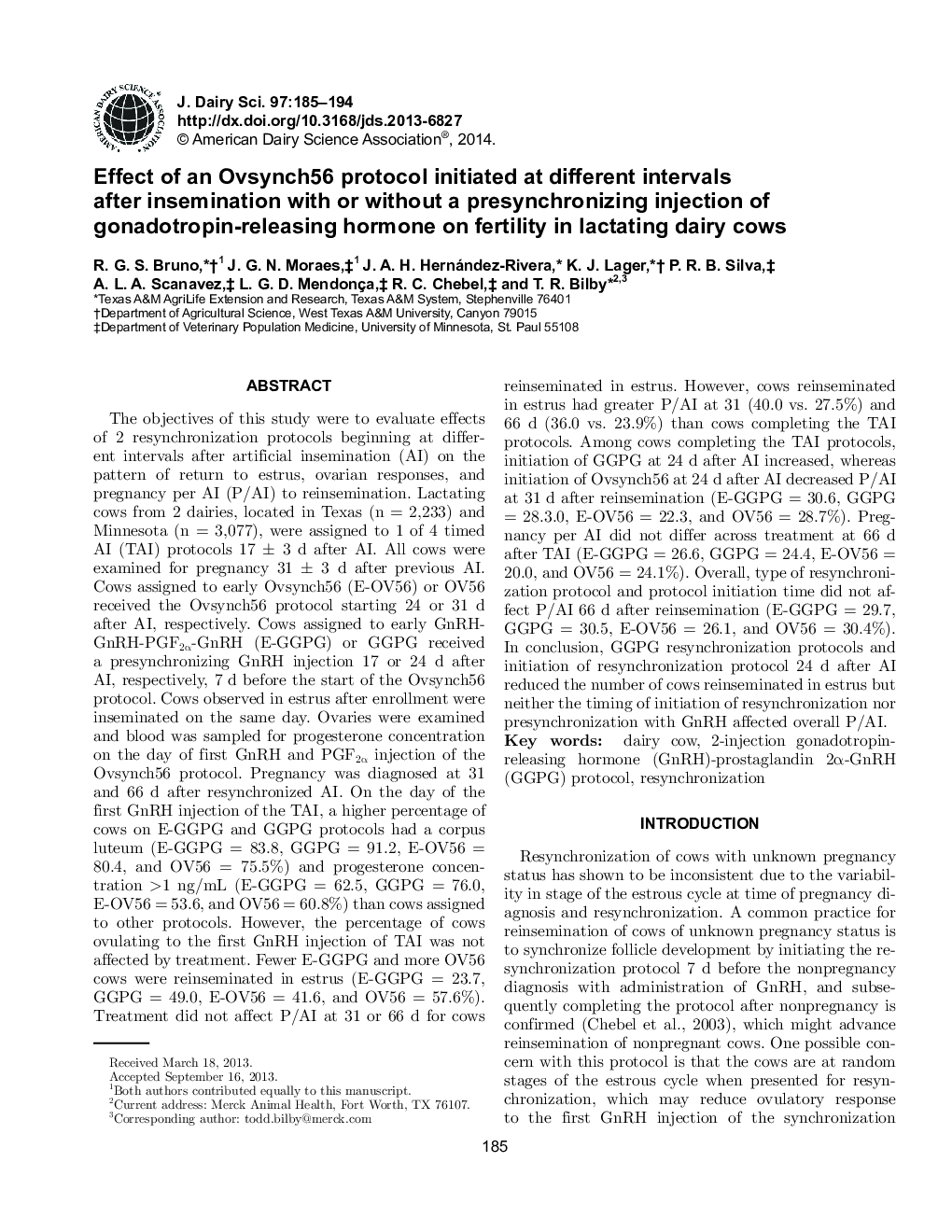| کد مقاله | کد نشریه | سال انتشار | مقاله انگلیسی | نسخه تمام متن |
|---|---|---|---|---|
| 10977706 | 1108052 | 2014 | 10 صفحه PDF | دانلود رایگان |
عنوان انگلیسی مقاله ISI
Effect of an Ovsynch56 protocol initiated at different intervals after insemination with or without a presynchronizing injection of gonadotropin-releasing hormone on fertility in lactating dairy cows
دانلود مقاله + سفارش ترجمه
دانلود مقاله ISI انگلیسی
رایگان برای ایرانیان
کلمات کلیدی
موضوعات مرتبط
علوم زیستی و بیوفناوری
علوم کشاورزی و بیولوژیک
علوم دامی و جانورشناسی
پیش نمایش صفحه اول مقاله

چکیده انگلیسی
The objectives of this study were to evaluate effects of 2 resynchronization protocols beginning at different intervals after artificial insemination (AI) on the pattern of return to estrus, ovarian responses, and pregnancy per AI (P/AI) to reinsemination. Lactating cows from 2 dairies, located in Texas (n = 2,233) and Minnesota (n = 3,077), were assigned to 1 of 4 timed AI (TAI) protocols 17 ± 3 d after AI. All cows were examined for pregnancy 31 ± 3 d after previous AI. Cows assigned to early Ovsynch56 (E-OV56) or OV56 received the Ovsynch56 protocol starting 24 or 31 d after AI, respectively. Cows assigned to early GnRH-GnRH-PGF2α-GnRH (E-GGPG) or GGPG received a presynchronizing GnRH injection 17 or 24 d after AI, respectively, 7 d before the start of the Ovsynch56 protocol. Cows observed in estrus after enrollment were inseminated on the same day. Ovaries were examined and blood was sampled for progesterone concentration on the day of first GnRH and PGF2α injection of the Ovsynch56 protocol. Pregnancy was diagnosed at 31 and 66 d after resynchronized AI. On the day of the first GnRH injection of the TAI, a higher percentage of cows on E-GGPG and GGPG protocols had a corpus luteum (E-GGPG = 83.8, GGPG = 91.2, E-OV56 = 80.4, and OV56 = 75.5%) and progesterone concentration >1 ng/mL (E-GGPG = 62.5, GGPG = 76.0, E-OV56 = 53.6, and OV56 = 60.8%) than cows assigned to other protocols. However, the percentage of cows ovulating to the first GnRH injection of TAI was not affected by treatment. Fewer E-GGPG and more OV56 cows were reinseminated in estrus (E-GGPG = 23.7, GGPG = 49.0, E-OV56 = 41.6, and OV56 = 57.6%). Treatment did not affect P/AI at 31 or 66 d for cows reinseminated in estrus. However, cows reinseminated in estrus had greater P/AI at 31 (40.0 vs. 27.5%) and 66 d (36.0 vs. 23.9%) than cows completing the TAI protocols. Among cows completing the TAI protocols, initiation of GGPG at 24 d after AI increased, whereas initiation of Ovsynch56 at 24 d after AI decreased P/AI at 31 d after reinsemination (E-GGPG = 30.6, GGPG = 28.3.0, E-OV56 = 22.3, and OV56 = 28.7%). Pregnancy per AI did not differ across treatment at 66 d after TAI (E-GGPG = 26.6, GGPG = 24.4, E-OV56 = 20.0, and OV56 = 24.1%). Overall, type of resynchronization protocol and protocol initiation time did not affect P/AI 66 d after reinsemination (E-GGPG = 29.7, GGPG = 30.5, E-OV56 = 26.1, and OV56 = 30.4%). In conclusion, GGPG resynchronization protocols and initiation of resynchronization protocol 24 d after AI reduced the number of cows reinseminated in estrus but neither the timing of initiation of resynchronization nor presynchronization with GnRH affected overall P/AI.
ناشر
Database: Elsevier - ScienceDirect (ساینس دایرکت)
Journal: Journal of Dairy Science - Volume 97, Issue 1, January 2014, Pages 185-194
Journal: Journal of Dairy Science - Volume 97, Issue 1, January 2014, Pages 185-194
نویسندگان
R.G.S. Bruno, J.G.N. Moraes, J.A.H. Hernández-Rivera, K.J. Lager, P.R.B. Silva, A.L.A. Scanavez, L.G.D. Mendonça, R.C. Chebel, T.R. Bilby,